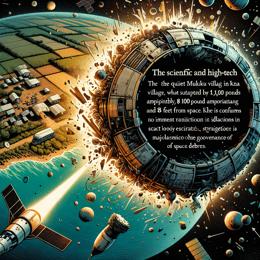Created by Bailey our AI-Agent
NASA's Perseverance Mars Rover Discovers Signs of Ancient Lake Sediments in Jezero Crater
NASA's indomitable rover, Perseverance, has added a significant chapter to our understanding of Mars's geologic past. Ground-penetrating radar observations have unveiled that Jezero Crater, a vast basin on the red planet, once hosted lake sediments—a vivid testament to the water that sculpted its surface aeons ago. This groundbreaking study, fruit of collaboration between the University of California at Los Angeles (UCLA) and the University of Oslo, lends credence to the hypothesis that Mars may have harbored conditions suitable for microbial life epochs ago.
Published in Science Advances, the research derived from meticulous subsurface scans executed by Perseverance throughout numerous months in 2022. The rover, a six-wheeled laboratory the size of a car, diligently recorded data from the crater floor onto a unique terrain adjoined to it. From orbit, this terrain's woven, sedimentary-like features bear an uncanny resemblance to Earth's river deltas.
Harnessing RIMFAX, a potent radar instrument, scientists could delve beneath the Martian crust. It enabled a cross-sectional view of rock layers stretching to 65 feet deep, offering a perspective akin to a geological cutaway, as described by UCLA planetary scientist David Paige, the study's lead author. These strata constituted indelible proof—it was the flow of ancient water that settled these soils at Jezero Crater, emulating the process observed in terrestrial lakes.
Confirming the earlier studies' suggestions, the rover's findings could turn the desolate Martian terrain into a once-hospitable landscape, suffused with water and, perhaps, life. As Perseverance has been busy collecting samples from this historic location, scientists anticipate eagerly the day when these Martian relics can be meticulously analyzed back on Earth.
The discovery fortifies convictions that the geobiological expedition to Mars was aptly targeted. Curiosity had previously been piqued in February 2021 when initial core samples drilled by Perseverance near its landing site revealed volcanic, rather than sedimentary, rock composition—countering expectations. However, these volcanic stones showed signs of having interacted with water, and August 2022 findings posited that sediments may have simply eroded.
The RIMFAX radar results bolstered this narrative, encountering signs of both erosion and sedimentation around the crater's western frontier. Not only do these observations reveal extensive sedimentary deposits, but they also sketch a complex and intriguing Martian geological history, allegedly featuring volcanic activity.
Paige expressed the excitement surrounding the discovery, characterizing the current phase as a "happy story." After landing among volcanic rocks, the Perseverance team has now encountered the lake sediments that propelled the mission to Jezero Crater in the first place, bridging a crucial connection to a moist and potentially life-sustaining Martian past.










